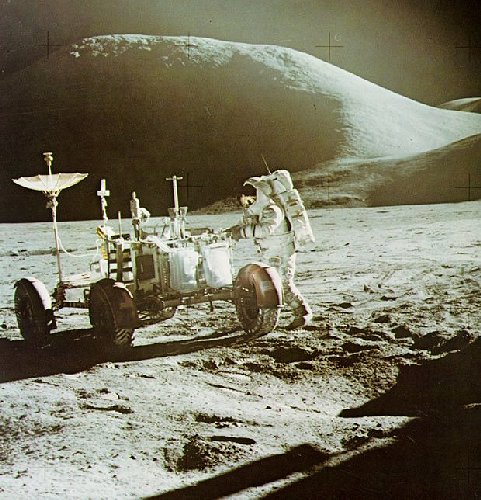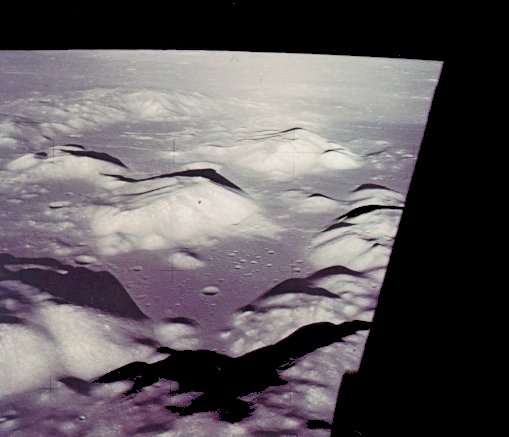
The Great Voyages Of Exploration
By HARRISON H. SCHMITT

|
|
Vistas without parallel in human experience surrounded
the crews on the great voyages of exploration.
Mount Hadley, rising 2 3/4 miles above the plain,
is Apollo 15's backdrop as Jim Irwin sets up the first
Lunar Roving Vehicle on the Moon.
(Photo captions for this chapter by the author.) |
First I want to share a new view of Earth? using the corrected vision of space. Like our childhood home, we really see the Earth only as we prepare to leave it. There are the basically familiar views from the now well-traveled orbits: banded sunrises and sunsets changing in seconds from black to purple to red to yellow to searing daylight and then back; tinted oceans and continents with structural patterns wrought by aging during four and a half billion years; shadowed clouds and snows ever-varying in their mysteries and beauty; and the warm fields of lights and homes, now seen without the boundaries in our minds.
Again like the childhood home that we now only visit- changing in time but unchanged in the mind- we see the full Earth revolve beneath us. All the tracks of man's earlier greatness and folly are displayed in the window: the Roman world, the explorers' paths around the continents, the trails across older frontiers, the great migrations of peoples. The strange perspective is that of the entire Earth filling only one window, and gradually not even doing that. No longer is it the Earth of our past, but only a delicate blue globe in space. With something of the sadness felt as loved ones age, we sec the full Earth change to half and then to a crescent and then to a faint moonlit hole in space. The line of night crosses water, land? and cloud, sending its armies of shadows ahead. We see that night, like time itself, masks but does not destroy beauty.
In sunlight, the sparkling sea shows its ever-changing character in the Sun's reflection, in varying hues of blue and green around the turquoise island beads, and in its icy competition with polar lands. The arcing, changing sails of clouds, following whirling, streaking pathways of wind, mark the passage of the airy lifeblood of the planet.

|
| Comparable to the Grand Canyon in scale and grandeur, the Valley of Taurus-Littrow extends some 20 miles through the ring of massifs surrounding the plains of the Serenitatis basin. In this westward-looking view from Apollo 17 LM Challenger, CSM America is the small central speck below and ahead, approaching the neck of the valley between the 1 1/2 mile high massifs. |
The revolving equatorial view concentrates our attention. There is the vast unbroken expanse of the Indian Ocean, south of the even more vast green and tan continent of Asia. In another complete view there are all of the blending masses of greens, reds, and yellows of Africa from the Mediterranean to the Cape of Good Hope, from Cap Vert to the Red Sea. Then we see across the great Atlantic from matching coast to matching coast. Scanning all of South America with one glance, we seemingly cease to move as the planet turns beneath us. And then there is the South Pacific. At one point only the brilliant ranges and plains of Antarctica remind a viewer that land still exists. The red continent of Australia finally conquers the illusion that the Earth is ocean alone, becoming the Earth's natural desert beacon.
When at last we are held to our own cyclic wandering about the Moon, we see Earthrise, that first and lasting symbol of a generation's spirit, imagination, and daring. That lonesome, marbled bit of blue with ancient seas and continental rafts is our planet, our home as men travel the solar system. The challenge for all of us is to guard and protect that home, together, as people of Earth.
| Next |